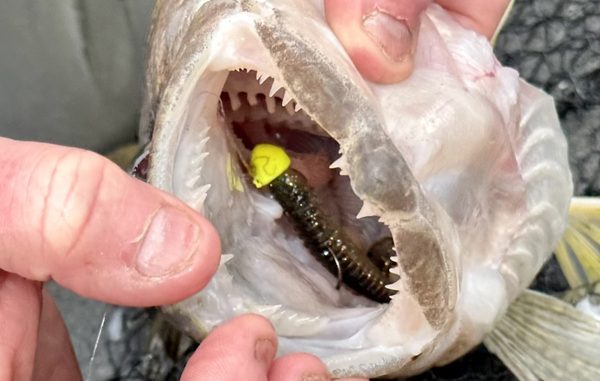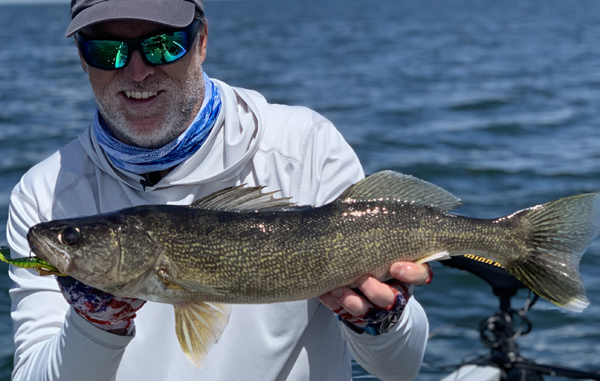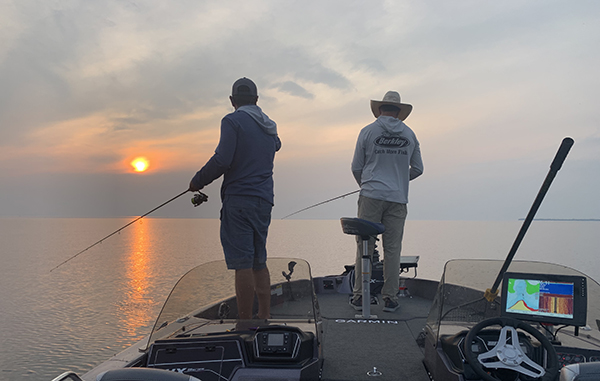Walleyes have a special place in the hearts of millions of anglers. That comes as no surprise…few fish are more fun to catch and none taste better when battered and pan fried in peanut oil.
I grew up in Minnesota, fishing hallowed walleye waters like Mille Lacs and Leech, before chasing them in places like the Columbia River, Green Bay, Lake Erie and even the mighty St. Lawrence River in Quebec.
Over the years, I experienced things that challenged much of what I thought I knew about walleye and forced me to try new techniques. With that in mind, here are my five favorite presentations for spring walleye.

1. Jig & Plastic
With today’s clear water, walleyes are more boat shy than ever. Reaching distant fish is key and a jig tipped with a modern soft plastic is a great choice, especially early in the season.
I like all forms of plastics in spring--minnow imitators, paddle tail swim baits, worms, shad bodies and even the ol’ curltail grub. Most anglers know how to fish a jig, but there are some tweaks when fishing plastics to make them more effective. For one, go with a medium, fast-action spinning rod and a size 30 spinning reel loaded with a quality 8-pound braid (with fluorocarbon leader for invisibility). Braid greatly increases your casting distance and sensitivity. Also, upsize your jig size to match the soft plastic you are using. Larger baits, especially those with a paddle tail, may require a ½ or even ¾ ounce jig to stay down, even in waters under 10 feet deep.
With straight-tail minnow baits, worms, and those with a small paddle tail, jigs in the ¼- to 3/8-ounce range are usually heavy enough to work shallow water. Whatever soft plastic you are fishing, its typically best to fish them more aggressively than you do with live bait. Your goal is to get fish to instinctively respond to fleeing prey.

2. Lipless Rippin’ Baits
A trip to Green Bay really opened my eyes to the power of lipless rippin’ baits on big spring walleye. We landed several big walleyes that weekend, including a 12-pound-plus giant.
Rippin’ baits like the new Berkley® Jack are superb on both pre- and post-spawn walleyes. The key is understanding when and how to use them. I like to fish these baits over shallow flats, gradual breaks and on top of points with scattered rock. Fish them like a jig; an aggressive rip up followed by a slack line pause. Most bites come on the fall.
Baitcasting gear with 10- to 12-pound fluoro is ideal for this presentation.
3. Slip Float and Live Bait
As much as I like fishing artificials, there are times when live bait shines. Pinning
a lively leech beneath a slip float is deadly when walleyes refuse to chase horizontal presentations.
LiveScope® has helped me understand how walleyes respond to various presentations including slip floats. Getting the bait down fast is more important than I realized. I now use larger floats with weighted base to improve line flow and add a 1/8 ounce egg sinker about 3 feet above the bait to get it down fast.
I typically use a tungsten jig when fishing a leech but will go to a plain hook when the bite is tough. Jig color matters some days. Black is my go-to, but gold, orange and chartreuse all have their days.
When targeting bottom-orientated walleye, run the bait about 18 inches off bottom, but watch your electronics for suspended fish. You’ll be surprised how often small pods of big walleye suspend 10- to 15-feet down. When I see these fish on my electronics, I quickly adjust my float to their depth and cast ahead of them…most of time they can’t resist a well-presented leech!
Eight-pound monofilament is tough to beat when setting up a float rod. It securely holds popular float stops, reducing the need to rerig between bites.

4. Crankbaits
I’m going to lump minnowbaits, jerkbaits and shad-style baits under the heading of “crankbaits” here because they are typically fished interchangeably when targeting spring walleye.
Cranks are a great choice for spring walleye. Trolling is especially deadly at dusk or after dark. In most waters, target depths from 5 to 12 feet, long-lining baits that run within a foot or so of bottom. Small jerks or rips of the rod will double your number of bites some days.
Don’t be afraid to go with large baits during the spring; this is a great time to break your personal best fish.
Pay attention to trolling speed using your GPS. I like to stay at about 1.1 MPH, going up or down as fish response is evaluated.
Casting cranks is a great option when fishing small structure, current seams, and other areas where trolling is not an option. Spinning gear loaded with 8-pound braid makes long casts easier and the sensitivity of braid will let you know if your bait is fouled with debris.
5. Jig and Minnow
Millions of walleye have been caught on jigs tipped with a live or dead minnow, and this combination is still deadly for walleye. This presentation has limitations, however. For one, finding bait can be challenging in this day of invasive species. Also, minnows rarely last long when making long casts to shallow fish.
But there are days when a jig-and-minnow is the best way to catch walleyes.
I like a jig-n-minnow when vertical jigging spring walleyes in rivers or when they are holding over structure. Drifting jigs is a great option when fishing scattered fish in depths of 5-15 feet of water, and casting then is a great option when drifting breaks and things like weedlines.
My jig boxes have hundreds of jigs of various sizes and colors, but I rely on three sizes most often—1/8, 1/4 and 3/8 when tipping with a minnow. In terms of colors, it’s hard to beat black, chartreuse, blue, orange or a combination of them most days.
With fatheads or large chubs, I hook the bait through both lips, but with shiners I typically run the hook through the mouth, out the gill and then bury it in the body of the fish. This helps reduce lost baits, a key for keeping costs down when shiner cost a buck or more apiece.
The traditional lift/drop presentation is still the best presentation most days, but when the bite is tough you may fish simple swimming the bait or dragging it is more effective.
Back to Blue Life
I grew up in Minnesota, fishing hallowed walleye waters like Mille Lacs and Leech, before chasing them in places like the Columbia River, Green Bay, Lake Erie and even the mighty St. Lawrence River in Quebec.
Over the years, I experienced things that challenged much of what I thought I knew about walleye and forced me to try new techniques. With that in mind, here are my five favorite presentations for spring walleye.

1. Jig & Plastic
With today’s clear water, walleyes are more boat shy than ever. Reaching distant fish is key and a jig tipped with a modern soft plastic is a great choice, especially early in the season.
I like all forms of plastics in spring--minnow imitators, paddle tail swim baits, worms, shad bodies and even the ol’ curltail grub. Most anglers know how to fish a jig, but there are some tweaks when fishing plastics to make them more effective. For one, go with a medium, fast-action spinning rod and a size 30 spinning reel loaded with a quality 8-pound braid (with fluorocarbon leader for invisibility). Braid greatly increases your casting distance and sensitivity. Also, upsize your jig size to match the soft plastic you are using. Larger baits, especially those with a paddle tail, may require a ½ or even ¾ ounce jig to stay down, even in waters under 10 feet deep.
With straight-tail minnow baits, worms, and those with a small paddle tail, jigs in the ¼- to 3/8-ounce range are usually heavy enough to work shallow water. Whatever soft plastic you are fishing, its typically best to fish them more aggressively than you do with live bait. Your goal is to get fish to instinctively respond to fleeing prey.

2. Lipless Rippin’ Baits
A trip to Green Bay really opened my eyes to the power of lipless rippin’ baits on big spring walleye. We landed several big walleyes that weekend, including a 12-pound-plus giant.
Rippin’ baits like the new Berkley® Jack are superb on both pre- and post-spawn walleyes. The key is understanding when and how to use them. I like to fish these baits over shallow flats, gradual breaks and on top of points with scattered rock. Fish them like a jig; an aggressive rip up followed by a slack line pause. Most bites come on the fall.
Baitcasting gear with 10- to 12-pound fluoro is ideal for this presentation.
3. Slip Float and Live Bait
As much as I like fishing artificials, there are times when live bait shines. Pinning
a lively leech beneath a slip float is deadly when walleyes refuse to chase horizontal presentations.
LiveScope® has helped me understand how walleyes respond to various presentations including slip floats. Getting the bait down fast is more important than I realized. I now use larger floats with weighted base to improve line flow and add a 1/8 ounce egg sinker about 3 feet above the bait to get it down fast.
I typically use a tungsten jig when fishing a leech but will go to a plain hook when the bite is tough. Jig color matters some days. Black is my go-to, but gold, orange and chartreuse all have their days.
When targeting bottom-orientated walleye, run the bait about 18 inches off bottom, but watch your electronics for suspended fish. You’ll be surprised how often small pods of big walleye suspend 10- to 15-feet down. When I see these fish on my electronics, I quickly adjust my float to their depth and cast ahead of them…most of time they can’t resist a well-presented leech!
Eight-pound monofilament is tough to beat when setting up a float rod. It securely holds popular float stops, reducing the need to rerig between bites.

4. Crankbaits
I’m going to lump minnowbaits, jerkbaits and shad-style baits under the heading of “crankbaits” here because they are typically fished interchangeably when targeting spring walleye.
Cranks are a great choice for spring walleye. Trolling is especially deadly at dusk or after dark. In most waters, target depths from 5 to 12 feet, long-lining baits that run within a foot or so of bottom. Small jerks or rips of the rod will double your number of bites some days.
Don’t be afraid to go with large baits during the spring; this is a great time to break your personal best fish.
Pay attention to trolling speed using your GPS. I like to stay at about 1.1 MPH, going up or down as fish response is evaluated.
Casting cranks is a great option when fishing small structure, current seams, and other areas where trolling is not an option. Spinning gear loaded with 8-pound braid makes long casts easier and the sensitivity of braid will let you know if your bait is fouled with debris.
5. Jig and Minnow
Millions of walleye have been caught on jigs tipped with a live or dead minnow, and this combination is still deadly for walleye. This presentation has limitations, however. For one, finding bait can be challenging in this day of invasive species. Also, minnows rarely last long when making long casts to shallow fish.
But there are days when a jig-and-minnow is the best way to catch walleyes.
I like a jig-n-minnow when vertical jigging spring walleyes in rivers or when they are holding over structure. Drifting jigs is a great option when fishing scattered fish in depths of 5-15 feet of water, and casting then is a great option when drifting breaks and things like weedlines.
My jig boxes have hundreds of jigs of various sizes and colors, but I rely on three sizes most often—1/8, 1/4 and 3/8 when tipping with a minnow. In terms of colors, it’s hard to beat black, chartreuse, blue, orange or a combination of them most days.
With fatheads or large chubs, I hook the bait through both lips, but with shiners I typically run the hook through the mouth, out the gill and then bury it in the body of the fish. This helps reduce lost baits, a key for keeping costs down when shiner cost a buck or more apiece.
The traditional lift/drop presentation is still the best presentation most days, but when the bite is tough you may fish simple swimming the bait or dragging it is more effective.
Back to Blue Life
